Beth Kanell's Blog, page 23
September 20, 2012
A Picture Tells a Story With Heart
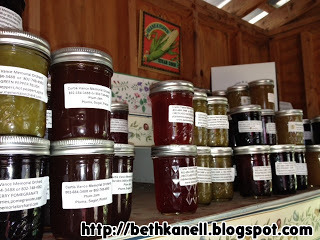
I love this image, which began with a photo I took a week ago inside the farm shop at the Langmaid farm in North Danville. You can see the rows of jellies and jams (I'll re-show, below, my other photo from that day, which shows the baked goods -- the donuts were flying out of there at 3 for a dollar).
And here are some parts of the story that come with the photo:
* North Danville, Vermont, is the location that inspired -- and really is the home of -- my 2011 mystery adventure THE SECRET ROOM. This little farm store is roughly where the imagined village store is, in the novel. And each time I'm in North Danville, I'm haunted by Shawna and Thea (from the novel) moving back and forth to each other's homes and discovering the secrets there.
* The jelly-jar labels include "Curtis Vance Memorial Orchard" as their first line. Curtis Vance lived in North Danville; he was a cousin of teacher and librarian Mary Prior, who insisted that I place a book in this place! The community that gathered around Curtis Vance during his long illness (familial ALS) was wide, deep, and loving. I enjoy seeing his name on the jars, even though I can't ever see him in person again.
* Autumn is my favorite season (is it yours, too?) -- my birthday is at the start of September, and I always have that "first day of school" excitement in my chest too. Most of all, I love the crispness, the scent of the air, the colors of the leaves, and the activities of harvest. "Putting food up" as jams, jellies, pickles, applesauce -- what could be a better statement of faith in the future?
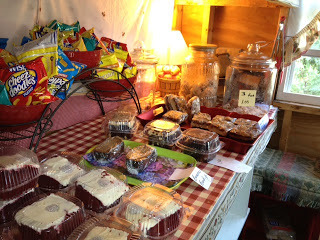 * Last but not least, I just took a class (yes, you can take classes from home, when you're a writer who loves to be at her desk) on Pinterest (ultimate in "new" -- contrast with the eons-old skills of preserving foods!) and figured out how to add this blogsite as an insert on my photo. It's still a bit basic; I'll be better next week. But I'm happy to be learning, and joyful to open the window and smell Autumn, and -- full circle -- thinking quietly again about Curtis Vance and Mary Prior. Life passes, and we are fortunate to preserve some of the "good food" to sample again later.
* Last but not least, I just took a class (yes, you can take classes from home, when you're a writer who loves to be at her desk) on Pinterest (ultimate in "new" -- contrast with the eons-old skills of preserving foods!) and figured out how to add this blogsite as an insert on my photo. It's still a bit basic; I'll be better next week. But I'm happy to be learning, and joyful to open the window and smell Autumn, and -- full circle -- thinking quietly again about Curtis Vance and Mary Prior. Life passes, and we are fortunate to preserve some of the "good food" to sample again later.
Published on September 20, 2012 10:29
September 14, 2012
History Behind the Story: From Vicki Delany, Author of MORE THAN SORROW (2012)
 LOYALISTS IN CANADA By Guest Author Vicki Delany
LOYALISTS IN CANADA By Guest Author Vicki DelanyHistory, they say, is written by the winner.It’s also written differently depending on what side you happen to be on.My newest book, More than Sorrow, is set in Prince Edward County, Ontario, where I live. I moved here four years ago and one of the first things I noticed was the sign as you approach the main town, Picton (pop 4,000) proclaiming “A Proud Loyalist Town”. Highway 33, which runs through the County along the north shore of Lake Ontario to Kingston, is named The Loyalist Highway, and signs depict a couple in period dress. What, thought I, is all this about? Then I began seeing flags – Union Jacks? Not quite. One of the stripes was missing.
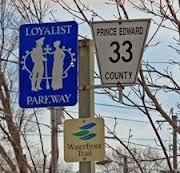 In Canada we have a reputation of ignoring our history. I can’t really be counted among those, as I’ve always had a keen interest in history. I majored in Modern History at University. (Although my major was Modern European History.) I knew something, vaguely, about the Loyalists who settled Ontario, but obviously not enough.So I set about learning. As Americans you might have been brought up to think that all but a few scoundrels and traitors were keen on independence. Not so fast. Apparently something like 30% of the residents of the colony thought it a bad idea. Only a few years prior to 1776 almost no one in the colony, including those who became the leading “patriots”, was arguing for independence, but for a slightly fairer tax system. It can be argued, and often has, that the revolution could easily have been prevented if the British had merely bent a little rather than remaining stubbornly intransigent. See
The
March of Folly
by Barbara Tuchman. (Highly recommended - one of the books that has had the most influence on my political thought.)Many Loyalists simply thought there was no reason to go to war over a tax dispute. Many agreed with aims of eventually achieving some degree of independence, but thought that Treason was not a good way to begin a county. Many were appalled at the actions of the mob – outright ‘confiscation of property’ aka theft, beating and killing supposed opponents – and thought no good could come of it. (In the famous quote attributed to Mather Byles, Boston Clergyman, “which is better – to be ruled by one tyrant three thousand miles away, or by three thousand tyrants not a mile away?”) Many simply didn’t want to take sides, and found themselves being forced to when their homes were torched and their property taken. When all the smoke had cleared, there were in excess of 60,000 people who chose to leave the new United States. (http://en.wikipedia.org/wiki/Loyalist_(American_Revolution)#Emigration_from_the_U.S.)
In Canada we have a reputation of ignoring our history. I can’t really be counted among those, as I’ve always had a keen interest in history. I majored in Modern History at University. (Although my major was Modern European History.) I knew something, vaguely, about the Loyalists who settled Ontario, but obviously not enough.So I set about learning. As Americans you might have been brought up to think that all but a few scoundrels and traitors were keen on independence. Not so fast. Apparently something like 30% of the residents of the colony thought it a bad idea. Only a few years prior to 1776 almost no one in the colony, including those who became the leading “patriots”, was arguing for independence, but for a slightly fairer tax system. It can be argued, and often has, that the revolution could easily have been prevented if the British had merely bent a little rather than remaining stubbornly intransigent. See
The
March of Folly
by Barbara Tuchman. (Highly recommended - one of the books that has had the most influence on my political thought.)Many Loyalists simply thought there was no reason to go to war over a tax dispute. Many agreed with aims of eventually achieving some degree of independence, but thought that Treason was not a good way to begin a county. Many were appalled at the actions of the mob – outright ‘confiscation of property’ aka theft, beating and killing supposed opponents – and thought no good could come of it. (In the famous quote attributed to Mather Byles, Boston Clergyman, “which is better – to be ruled by one tyrant three thousand miles away, or by three thousand tyrants not a mile away?”) Many simply didn’t want to take sides, and found themselves being forced to when their homes were torched and their property taken. When all the smoke had cleared, there were in excess of 60,000 people who chose to leave the new United States. (http://en.wikipedia.org/wiki/Loyalist_(American_Revolution)#Emigration_from_the_U.S.)
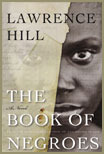 They were refugees in every sense of the word. The British army and government remained loyal to those who’d been loyal to them, and provided transportation away from the States for anyone who wanted to leave. Many went back to England or Scotland, many to parts of North America that were not yet American, such as Florida, and many to the West Indies. When I was in Turks and Caicos in the winter, we visited the remains of a loyalist plantation. Slaves who had supported the British side were given their freedom and a spot on a ship out. Many of them settled in Nova Scotia, where their descendants live today, and some went back to Africa. (If you are interested in the Black Loyalist story, try the superb
Book Of Negroes
by Lawrence Hill. That’s the book’s Canadian name; it has something different in the U.S. [Someone Knows My Name -- BK] The Book of Negroes was the list the British kept in New York of blacks wanting to flee.)
They were refugees in every sense of the word. The British army and government remained loyal to those who’d been loyal to them, and provided transportation away from the States for anyone who wanted to leave. Many went back to England or Scotland, many to parts of North America that were not yet American, such as Florida, and many to the West Indies. When I was in Turks and Caicos in the winter, we visited the remains of a loyalist plantation. Slaves who had supported the British side were given their freedom and a spot on a ship out. Many of them settled in Nova Scotia, where their descendants live today, and some went back to Africa. (If you are interested in the Black Loyalist story, try the superb
Book Of Negroes
by Lawrence Hill. That’s the book’s Canadian name; it has something different in the U.S. [Someone Knows My Name -- BK] The Book of Negroes was the list the British kept in New York of blacks wanting to flee.)
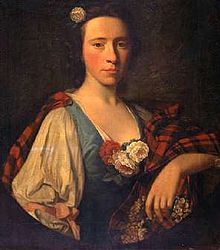 Flora McDonald
Flora McDonald
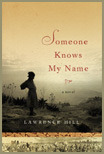 People you might think had no love for the British remained loyal. I was surprised to learn what firm Loyalists many Scots were. One would assume that having fought so hard against the English in 1745 they would be on the anti-British side. Nope. A lot of Scots who’d come to America after the Battle of Culloden were Loyalists. One of Scotland’s greatest heroines, Flora McDonald, savior of Bonnie Prince Charlie after Culloden, moved to America, and became a staunch Loyalist. After the American Revolution she returned via Canada to Skye, where she remained until she died. According to a source I read, the Jacobites did not consider themselves to be ‘rebels’ in any way. They supported what they considered to be the true King of Scotland. Thus were not inclined to support rebellion in America. A great many of these refugees came to Canada, over a thousand to what is now Prince Edward County. What I hadn’t fully realized is that Ontario was almost totally unsettled at that time. Canada consisted of French Quebec and some settlements in Nova Scotia. A small township had been established in the Niagara area. And that was it. So when the new settlers came to this area there was nothing but wilderness. No roads, no towns. Nothing but dark, impenetrable forest.
People you might think had no love for the British remained loyal. I was surprised to learn what firm Loyalists many Scots were. One would assume that having fought so hard against the English in 1745 they would be on the anti-British side. Nope. A lot of Scots who’d come to America after the Battle of Culloden were Loyalists. One of Scotland’s greatest heroines, Flora McDonald, savior of Bonnie Prince Charlie after Culloden, moved to America, and became a staunch Loyalist. After the American Revolution she returned via Canada to Skye, where she remained until she died. According to a source I read, the Jacobites did not consider themselves to be ‘rebels’ in any way. They supported what they considered to be the true King of Scotland. Thus were not inclined to support rebellion in America. A great many of these refugees came to Canada, over a thousand to what is now Prince Edward County. What I hadn’t fully realized is that Ontario was almost totally unsettled at that time. Canada consisted of French Quebec and some settlements in Nova Scotia. A small township had been established in the Niagara area. And that was it. So when the new settlers came to this area there was nothing but wilderness. No roads, no towns. Nothing but dark, impenetrable forest.
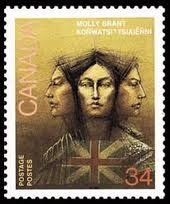 Molly Brant led Mohawk LoyalistsNot even Native Canadians. There’s a big Mohawk Reserve near the County called Tyendenaga. It was settled by Loyalists also. The Indians fought on the side of the British in the Revolution (as they did in the War of 1812) and when their side lost, they lost their land and became refugees. Many of these refugees were not farmers: they might be townspeople, shopkeepers, newspapermen, tradesmen, maybe soldiers. As is the case with refugees down through time, most of them lost everything except the clothes they stood in when they fled their homes. The British government gave them transportation, and some supplies with which to begin. Imagine facing the true North American Wilderness, with a handful of seeds, a hand-made axe, maybe an ox to share with your neighbours, and no farming experience. The first order of business would have been to chop down a patch of ancient forest, to clear land and get wood to start building. They lived in tents or rough shacks the first years. In Ontario – in winter! When I decided I wanted to write another stand-alone suspense novel, I knew I wanted it to be a modern gothic, a book with strands of the past and hidden secrets affecting people today. I am interested in how war affects lives, particularly the non-combatants, and quickly came up with the idea of a war correspondent injured in Afghanistan and a young female Afghan refugee. Refugee? Where had I heard that before? Thus, in telling the story of Maggie Macgregor, a Loyalist refugee, I hoped to draw parallels between the refugee experience of Canada’s original settlers with those arriving today. And hopefully I have also had something to say about universal truths, particularly of women caught up in a fight that is not their own.
Molly Brant led Mohawk LoyalistsNot even Native Canadians. There’s a big Mohawk Reserve near the County called Tyendenaga. It was settled by Loyalists also. The Indians fought on the side of the British in the Revolution (as they did in the War of 1812) and when their side lost, they lost their land and became refugees. Many of these refugees were not farmers: they might be townspeople, shopkeepers, newspapermen, tradesmen, maybe soldiers. As is the case with refugees down through time, most of them lost everything except the clothes they stood in when they fled their homes. The British government gave them transportation, and some supplies with which to begin. Imagine facing the true North American Wilderness, with a handful of seeds, a hand-made axe, maybe an ox to share with your neighbours, and no farming experience. The first order of business would have been to chop down a patch of ancient forest, to clear land and get wood to start building. They lived in tents or rough shacks the first years. In Ontario – in winter! When I decided I wanted to write another stand-alone suspense novel, I knew I wanted it to be a modern gothic, a book with strands of the past and hidden secrets affecting people today. I am interested in how war affects lives, particularly the non-combatants, and quickly came up with the idea of a war correspondent injured in Afghanistan and a young female Afghan refugee. Refugee? Where had I heard that before? Thus, in telling the story of Maggie Macgregor, a Loyalist refugee, I hoped to draw parallels between the refugee experience of Canada’s original settlers with those arriving today. And hopefully I have also had something to say about universal truths, particularly of women caught up in a fight that is not their own. ***Vicki Delany's newest book, MORE THAN SORROW, is a "modern Gothic" novel reviewed at the Kingdom Books review blog; for more of this author's insight into the genre, see her other article here. Thanks, Vicki, for sharing your history and story with us!
Published on September 14, 2012 17:15
September 11, 2012
American History/Canadian History: Vicki Delany Dishes on the Differences (and the Story!)
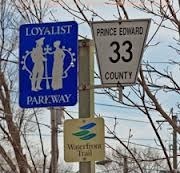 Ready to find out who the Loyalists were around the time of the American War of Independence, and how their role developed in Canadian author Vicki Delany's new novel MORE THAN SORROW? Check in here on Friday Sept. 14; it's a story with huge significance, and lots of new aspects to consider. Photo here provided by Vicki, signs on the Loyalist Parkway on Prince Edward County, Ontario, Canada.
Ready to find out who the Loyalists were around the time of the American War of Independence, and how their role developed in Canadian author Vicki Delany's new novel MORE THAN SORROW? Check in here on Friday Sept. 14; it's a story with huge significance, and lots of new aspects to consider. Photo here provided by Vicki, signs on the Loyalist Parkway on Prince Edward County, Ontario, Canada.
Published on September 11, 2012 13:37
September 8, 2012
Calendar Alert: Coming Soon (Sept. 14), A Guest Appearance from Canadian Author Vicki Delany
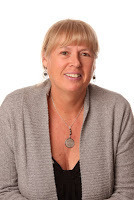 Vicki DelanyVicki Delany's new book MORE THAN SORROW pushed me to grapple with the situation in America and Canada in 1776, when rebellion overtook the American Colonies and "Loyalists" either fought against the prevailing mood, retreated to England, or escaped as refugees to Canada. I was surprised at how strongly I felt about those Loyalists! It took a couple of chapters of Delany's very good "modern Gothic" mystery, set in Ontario, Canada, to push me into giving them a fair shake.
Vicki DelanyVicki Delany's new book MORE THAN SORROW pushed me to grapple with the situation in America and Canada in 1776, when rebellion overtook the American Colonies and "Loyalists" either fought against the prevailing mood, retreated to England, or escaped as refugees to Canada. I was surprised at how strongly I felt about those Loyalists! It took a couple of chapters of Delany's very good "modern Gothic" mystery, set in Ontario, Canada, to push me into giving them a fair shake.So I'm very excited that Vicki plans to post here on "Stories That Matter" -- tentatively scheduled for Sept. 14. I can already promise this: She'll get us thinking, and we'll be intrigued.
Published on September 08, 2012 10:37
Chinatowns: From Exclusion to Pride
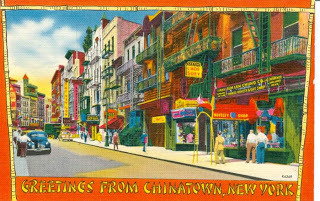 Behind the story of COLD MIDNIGHT, my new Vermont mystery that will release on Nov. 3, are a lot of scattered people and facts, ranging from finding out that high school and college students really do challenge themselves to climb up the outsides of buildings (without getting hurt or caught -- believe me, I would not do this!); learning about an unsolved murder in the neighboring town of St. Johnsbury, Vermont; and having in mind the lack of treatment for "shell shock" for veterans of World War I.
Behind the story of COLD MIDNIGHT, my new Vermont mystery that will release on Nov. 3, are a lot of scattered people and facts, ranging from finding out that high school and college students really do challenge themselves to climb up the outsides of buildings (without getting hurt or caught -- believe me, I would not do this!); learning about an unsolved murder in the neighboring town of St. Johnsbury, Vermont; and having in mind the lack of treatment for "shell shock" for veterans of World War I.But as the story grew, so did my attention to a terrible piece of U.S. federal legislation from 1882 (and not really disbanded until World War I), the Chinese Exclusion Act. It is in large part because of this act, which prevented Chinese from becoming naturalized U.S. citizens, that Chinatowns became part of American life.
Somewhere in the 20th century, though, Chinatowns became a source of great pride: They are the homes to many Americans who treasure their Chinese heritage and savor the sound of Chinese languages, the scent and flavor of long-familiar recipes, the "at home" feeling of being among people who understand more of your background and who don't make casual assumptions based on the shape of your face or color of your skin.
Chinatowns are also "destinations" now, where tour guides or guidebooks direct eager visitors. And they are places where festivals are celebrated, inviting local news teams and photographers to delight in the activities they can capture on film.
There's much more to be said about Chinatowns, and wonderful books that say some of it -- including the mysteries written by Henry Chang, who sets his books in the New York City Chinatown where he grew up (three available through Soho Crime; the fourth is on its way). I emailed to Henry a copy of the postcard shown here, a festive tourist scene if ever there was one, and here's what he told me:
the postcard is accurate for Mott St. looking toward Pell, circa 1950's maybe. The names of the restaurants and shops are places I remember, growing up. Tai Yat Low restaurant was on the corner of Mott and Pell sts. The bldgs on the left are accurate as some I recognize and the rooflines are pretty much the same today... [He then added] Correction,- Tai Yat Low was on Mott as depicted, and further toward the left, a red sign that looks like a music note, was Lee's Restaurant, on the corner of Mott and Pell sts. Btw I've used the corner bldg on Mott and Pell as a location in Book Four ( the first draft of which I've just finished...)Also, here's a photo that I snapped in Boston's Chinatown, which I toured in 2010 through the Chinese Historical Society of New England (thank you again!).
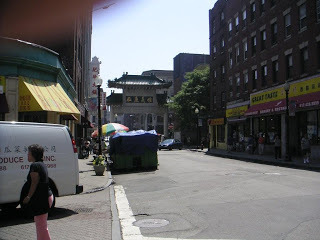
Which Chinatowns have you visited (or lived in)? What did you experience there? When are you going to take part in one again?
Published on September 08, 2012 10:13
Chinatowns: When Exclusion Becomes Joy
 Behind the story of COLD MIDNIGHT, my new Vermont mystery that will release on Nov. 3, are a lot of scattered people and facts, ranging from finding out that high school and college students really do challenge themselves to climb up the outsides of buildings (without getting hurt or caught -- believe me, I would not do this!); learning about an unsolved murder in the neighboring town of St. Johnsbury, Vermont; and having in mind the lack of treatment for "shell shock" for veterans of World War I.
Behind the story of COLD MIDNIGHT, my new Vermont mystery that will release on Nov. 3, are a lot of scattered people and facts, ranging from finding out that high school and college students really do challenge themselves to climb up the outsides of buildings (without getting hurt or caught -- believe me, I would not do this!); learning about an unsolved murder in the neighboring town of St. Johnsbury, Vermont; and having in mind the lack of treatment for "shell shock" for veterans of World War I.But as the story grew, so did my attention to a terrible piece of U.S. federal legislation from 1882 (and not really disbanded until World War I), the Chinese Exclusion Act. It is in large part because of this act, which prevented Chinese from becoming naturalized U.S. citizens, that Chinatowns became part of American life.
Somewhere in the 20th century, though, Chinatowns became a source of great joy: They are the homes to many Americans who treasure their Chinese heritage and savor the sound of Chinese languages, the scent and flavor of long-familiar recipes, the "at home" feeling of being among people who understand more of your background and who don't make casual assumptions based on the shape of your face or color of your skin.
Chinatowns are also "destinations" now, where tour guides or guidebooks direct eager visitors. And they are places where festivals are celebrated, inviting local news teams and photographers to delight in the activities they can capture on film.
There's much more to be said about Chinatowns, and wonderful books that say some of it -- including the mysteries written by Henry Chang, who sets his books in the New York City Chinatown where he grew up (three available through Soho Crime; the fourth is on its way). I emailed to Henry a copy of the postcard shown here, a festive tourist scene if ever there was one, and here's what he told me:
the postcard is accurate for Mott St. looking toward Pell, circa 1950's maybe. The names of the restaurants and shops are places I remember, growing up. Tai Yat Low restaurant was on the corner of Mott and Pell sts. The bldgs on the left are accurate as some I recognize and the rooflines are pretty much the same today... [He then added] Correction,- Tai Yat Low was on Mott as depicted, and further toward the left, a red sign that looks like a music note, was Lee's Restaurant, on the corner of Mott and Pell sts. Btw I've used the corner bldg on Mott and Pell as a location in Book Four ( the first draft of which I've just finished...)Also, here's a photo that I snapped in Boston's Chinatown, which I toured in 2010 through the Chinese Historical Society of New England (thank you again!).

Which Chinatowns have you visited (or lived in)? What did you experience there? When are you going to take part in one again?
Published on September 08, 2012 10:13
August 22, 2012
Research, Research, Suspense!
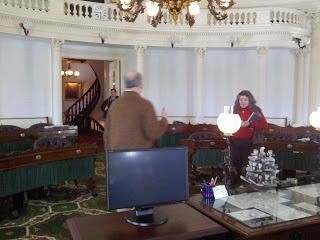 With enough research, the suspense starts jumping up and down and I can hardly wait to get writing the next chapter! I suppose that's the opposite of "writer's block." I love it!
With enough research, the suspense starts jumping up and down and I can hardly wait to get writing the next chapter! I suppose that's the opposite of "writer's block." I love it!The amazing Cheryl Minden designed a cover for ALL THAT GLITTERS, the first volume of the "Vermont Nancy Drew" series I'm working on. Finalizing it with Cheryl, along with the lovely change in weather -- not humid any longer -- and some gifts of time from my family have all come together into the energy to round up the research for the new chapter. And it's online. Yay!
Today's photo shows some of the in-person research at Vermont's State House, with the curator of state buildings, David Schütz, in the Senate Chamber that teen sleuth Lucky Franklin enters in chapter 26. And for an extra visual bonus today, here's the cover! Thank you so much, Cheryl!!
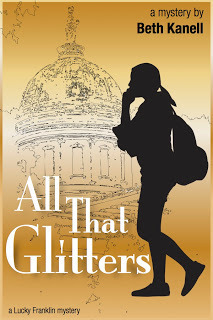
Published on August 22, 2012 12:38
August 19, 2012
A New England Town Re-Shaped by Fire
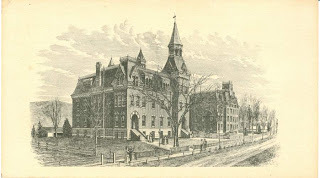
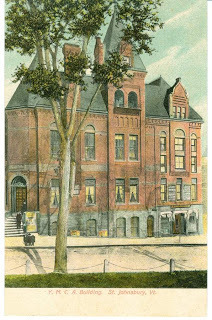 Yesterday my husband Dave and I browsed a postcard "show" -- really a marketplace, with a dozen or so dealers, and hundreds of thousands of postcards, many of them images of buildings, railroads, and people long gone. It was a historian's treasure trove, and we won't be going out to dinner again for quite a while, because we gathered so many of the 3.5 by 5.5 inch cards to bring home with us. I don't think either one of us purchased a modern "color photo" postcard; we chose the early black-and-white ones, mostly camera shots but some hand drawn or etched, and a few hand-tinted with washes of pastel color.
Yesterday my husband Dave and I browsed a postcard "show" -- really a marketplace, with a dozen or so dealers, and hundreds of thousands of postcards, many of them images of buildings, railroads, and people long gone. It was a historian's treasure trove, and we won't be going out to dinner again for quite a while, because we gathered so many of the 3.5 by 5.5 inch cards to bring home with us. I don't think either one of us purchased a modern "color photo" postcard; we chose the early black-and-white ones, mostly camera shots but some hand drawn or etched, and a few hand-tinted with washes of pastel color.Probably the most compelling in Dave's batch were a pair that showed the disaster of a winter fire that wiped out half the downtown structures of Lyndonville, Vermont, in 1924. Dave will be doing his own posts about that (at the moment, he "does" Lyndonville and I "do" four other neighboring towns). But I want to share the link to a remarkable video we found that narrates the blaze and its results, as well as showing a number of the postcards that were printed at the time to show the disaster. The video is by Lindsay Marcotte, who was a student at today's Lyndon Institute when she made it. Here it is: http://youtu.be/o0JtuL5SK7Y
It's remarkable that Lyndonville looks untouched today (and there have been other fires since then, too).
In Cold Midnight, the novel I'll bring out in November of this year, Claire Benedict climbs the roofs of St. Johnsbury at night; in the first chapter, she sees a fire being "set." Most downtown structure fires in northern New England have been accidental, but St. Johnsbury and Lyndonville (neighboring large towns) have both seen terrible cases of arson. Two imposing buildings that were lost within the last couple of generations were North Hall of St. Johnsbury Academy, and the Y.M.C.A. building on Eastern Avenue. I've put the postcards showing these onto the Cold Midnight Pinterest board, and I'm placing them here, too, for easy access. North Hall (top image, with South Hall more distant) was lost in 1956, and the Y.M.C.A. building in 1984.
A peek into the possible fiction future: I've started another novel called The Fire Curse that works with all those fires. It's not the next one in my queue to complete, but ... I'll get there, one of these days.
Published on August 19, 2012 13:07
August 14, 2012
Cold Midnight: A Cover, and a Release Date!
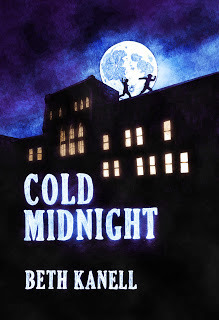 Thanks to the fantastic team at Raphel Publishing, COLD MIDNIGHT is headed toward a November 3, 2012, release -- and designer Jacob Grant provided this great draft cover today, which will probably get polished a bit more as the book comes together.
Thanks to the fantastic team at Raphel Publishing, COLD MIDNIGHT is headed toward a November 3, 2012, release -- and designer Jacob Grant provided this great draft cover today, which will probably get polished a bit more as the book comes together.Editor Adrienne Raphel and I are working on making this the best book yet. In fact, tomorrow I'll be "unreachable" as I buckle down to revisions based on our discussions. I love working with Adrienne -- she and I have similar beliefs about what a good story does for the reader.
And here's a summary of COLD MIDNIGHT, now on the Sisters in Crime (New England) website:
For high school freshman Claire Benedict, the pressures of home and school are huge -- her father is home from the Great War now that it's 1921, but he's too depressed to work, her mother is furious at still supporting the family, Claire's friends have stepped aside, and teachers pick on her for her family background. So climbing the downtown roofs at night gives her a world of her own, free and wide-ranging. To her surprise, there's another night climber: Ben Riley, looking for a miracle. When the two of them witness both an arsonist and a late-night poker game that ends in murder, their sleuthing turns risky. Skills alone won't get them through the dangers that lie ahead.For a look at some of the photos (and fires!) behind the story, check out the connected Pinterest borad here: http://pinterest.com/bethkanell/cold-midnight-climbing-on-roofs-at-night-solving-c
I'm looking forward to your comments!
Published on August 14, 2012 11:48
August 2, 2012
One Mind, Many Paths
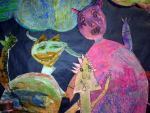 Wild things, from the IAB.My favorite "pithy quote" for acknowledging and enjoying spiritual diversity is "One mountain, many paths" -- it tags both my belief about the way different minds and souls need to approach Meaning in different ways, and my attachment to the mountain landscape here in Vermont.
Wild things, from the IAB.My favorite "pithy quote" for acknowledging and enjoying spiritual diversity is "One mountain, many paths" -- it tags both my belief about the way different minds and souls need to approach Meaning in different ways, and my attachment to the mountain landscape here in Vermont.After a delighted browse through the website and blog of the Integrated Arts Academy in Burlington, Vermont, this morning, my version for the day is, "One mind, many paths."
For perhaps three decades or more, educators and others who ponder how we share our stories and our humanity have recognized the validity of "multiple intelligences": Some of us shine in our approach to words, others through numbers, others through music or visual arts or culinary arts. And that's the reason that so many curriculum guides to youth literature include visual arts and sometimes recipes in the guides.
However, a teaching enterprise like the Integrated Arts Academy is a reminder that we can't expect to stick on "arts" exercises as if they were stamps to fill a page, and then expect "the kids" to connect. Instead, on the best of our days and in the best of classrooms, the multiple receptors of every student come first in planning how to introduce and develop a topic.
In writing The Secret Room, my choice was to focus in each chapter on all five of my senses, but most especially to pay attention to scent, fragrance, what things smell like. Marcel Proust, of course, reminded us that the scent of a single cookie can bring back an era and a set of attachments. For me, the scent of horse manure, the dairy barn, and the cedar fragrance of a well-sawdusted chicken house all evoke different times and meanings from my life. And I deliberately bring them into my stories, to let readers build from those reminders also. (I'll talk about "sound" in terms of my newest book, due out this fall, Cold Midnight.)
In an integrated arts curriculum, there must be five "senses" in another way. Suppose one of them is rooted in paying attention to where we are: the sense of place. In the same way that a festival flag for "MOUNTAIN" is just the start of exploring what a mountain is -- and what a Vermont mountain is, and what it feels like, acts like, means in our story -- we can approach a moment of history or a set of characters and call forth their attachment to the exact place they inhabit.
What are the senses you use as you savor the place where you are today? List three important qualities of the where/when of your day. How could each one nourish your own hunger for learning and for creating?
Published on August 02, 2012 05:19



